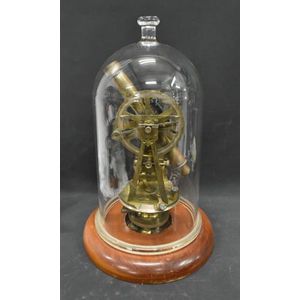Thwaites & Reed Skeleton Clock with Glass Dome
You must be a subscriber, and be logged in to view price and dealer details.
Subscribe Now to view actual auction price for this item
When you subscribe, you have the option of setting the currency in which to display prices to $Au, $US, $NZ or Stg.
- Cartouche - An ornamental panel in the form of of a shield, oval or rectangular scroll with curling edges. It may be carved into the back of a chair or the top of a sideboard, or present on a piece of silver or jewellery, and contain the initials of the original owner, heraldic symbols, or some other inscription, such as the details of a presentation.
In ceramics the term defines the central area of a vase or similar with a decorative border in one of the shapes above, into which a decorative scene or figures have been painted. - Alabaster - Alabaster is soft natural stone used for statuary, with a similar appearance to marble, but easier to work with. As it is softer than marble, an item made from alabaster can be scratched with a metal object, and an alabaster item does not polish to a high surface gloss like marble.
Alabaster objects can be semi-translucent. Alabaster occurs in a pure white form and also with veining from dirt. Colours vary from white through yellow and pink to brown. The veining is usually green or black but can be multicoloured.
Being semi-translucent, alabaster is often used for the bowls of figural lamps, with the figure itself being either alabaster or marble. - Chapter Ring - A separate metal plate on the face of a clock, on which the numerals for the hours and sometimes parts of the hours, are displayed, usually wheel shaped and sitting on top of the dial plate. The chapter ring is often a feature of the clock and can be silvered or enamelled to stand as a contrast to its background. The hours are usually shown in Roman numerals, although in the late 19th and earlt 20th century, Arabic numerals became fashionable.
- Timepiece - In today's usage, the word "clock" is the name given to any instrument used for measuring time, but the word clock is derived from the Celtic word meaning "bell", and traditionally a clock without a bell or chime was known as a timepiece.
This item has been included into following indexes:
-
clocks, type
- skeleton 78
- under glass dome 198
- meat covers / food covers / dish covers - pewter 1,629
Visually similar items

Royal Crown Derby 'Heraldic Lion' paperweight limited edition No 1750 of 2000, with certificate, comes with original box, 13.5 cm high approx.

Royal Worcester Harry Stinton pot pourri vase & cover painted with highland cattle, numbered 278. Height 13 cm

Royal Worcester pot pourri vase with 'Highland Cattle' hand painted by Harry Stinton

A Tornaghi & Co, Sydney brass theodolite, on timber stand, under a glass dome, height 48 cm incl. Dome
